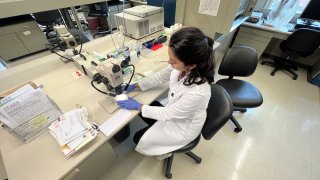
The tick testing laboratory at the Connecticut Agricultural Experiment Station (CAES) has recorded a 20% increase in tick submissions compared to this time last year, already receiving more than 2,500 ticks from across the state.
“The era when we are used to just the blacklegged tick and Lyme disease is past gone. We are dealing with a number of tick species and tick-borne diseases," said Dr. Goudarz Molaei, who leads the tick testing laboratory at the CAES. "Particularly the invasive tick species that have taken home here in Connecticut.”
The lab invites Connecticut residents to submit ticks for testing. The lab used to record about 3,000 submissions annually. Now, the lab receives about 6,000 submissions on an annual basis.
Get Connecticut local news, weather forecasts and entertainment stories to your inbox. Sign up for NBC Connecticut newsletters.
“We are dealing with up to 12 diseases that ticks transmit in our region. This altogether creates a situation that is quite difficult to handle and public health authorities are struggling to deal with all of this tick activity and tick-borne diseases.”
According to Dr. Molaei, there are a number of factors contributing to the higher tick activity and higher prevalence of tick-borne diseases.
“The most important factor is climate change," said Dr. Molaei. "Climate change is leading to having a very short winter without bitterly cold temperature that ticks are surviving better.”
Local
Dr. Molaei said that climate change is also impact hosts for ticks.
“Climate change is impacting the whole environment altogether and as a result we are seeing that is creating a perfect situation not only for ticks, but tick-borne diseases," said Dr. Molaei.
People who spend time outside are encouraged to avoid tall grass, wear repellent and light clothing. It is also important to check for ticks.
For information on how to submit a tick to the CAES, click here.



